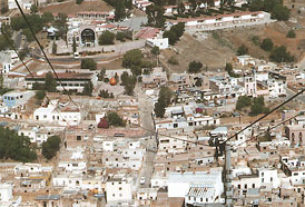Corazoncita, or little heart, is a Mexican expression of affection, similar to ‘sweetheart’. This is a story of my first visit to Mexico, and how a sweet, little Mexican girl became mi corazoncita. The only deviation from reality is the use of a false name for her, necessary because of her current participation in Mexican politics.
In 1983, after eight years of marriage to Margarita, a native of Puebla, I ran out of excuses and finally visited Mexico.
Margarita had decreed that her daughter, Clarissa, should have a quinceañera (a traditional ceremony marking a girl’s fifteenth birthday, when she is traditionally considered old enough to marry, the quinceañera is relevant to this story only because it prompted my first visit to Mexico) at her sister’s apartment in Mexico City, and I must appear for the ceremony.
“Yes, dear.”
Manzana 2, that is, Apple two, is a large Mexico City apartment complex, located near Metro stop Politécnico. There must be dozens or maybe hundreds of condominiums in the complex, but I could never navigate the maze well enough to count them. Each building has four stories, and two entrances. Each entrance provides access to two apartments on the left, and two more on the right, times four stories, is 32 apartments. Each apartment has a locked, wire cage on the roof, with a ‘Mexican Maytag’ (two concrete sinks and faucets for washing clothes by hand), and clothes lines. The buildings are distributed around the complex at varying angles and distances.
Sidewalks run down the middle of the grassy area between buildings. There are a number of playgrounds, beaten into total submission. A kindergarten and a primary school in the complex keep the younger kids near home. There is a sunken amphitheater, for plays, poetry readings, prayer meetings, and theater. Clarissa also had her ceremonial quinceañera dance there.
Many of the apartments have small balconies, and exotic flowers bloom profusely in window pots. Some of the ground floor apartments have patio doors installed, so the grassy areas can be accessed directly. Car traffic is restricted to the perimeter of the complex, so there is little traffic noise. It’s a short walk to grocery stores, panaderias, tortillerias, and the metro.
Green grass; trees; lots of flowers; smiling women and children; men hurrying to work; a gentle rain most May afternoons, and blue sky the rest of the day; quiet except for happy people noise.
In the insanity called Mexico City, Manzana 2 in 1983 was not a bad place to live.
My sister-in-law’s two bedroom apartment was about 600 square feet, for six people, increasing to ten or twenty at times. In the U.S., we say, “Call first.” In Mexico, they say, “Here we are!” From mid-morning until late evening, I sat in a convenient chair, in shock, as uncountable hordes of people came in the door, hugged and kissed everyone, shook my hand and made happy sounds in Spanish, laughed, talked, gossiped, hugged and kissed again, then disappeared.
They live this way every day! Fiesta days are even worse.
Mexico can be a very alien place for the first-timer, especially away from the tourist centers. I had no idea what anyone was saying, or doing, or what anything meant. One of my nieces, eleven year old Liliana, was the only one who spent much time with me. Liliana has typical Aztec features, and, at age 11, had the calm, mysterious beauty of the Madonna. She was a very sweet, little girl, and so intelligent that she answered my questions by the hour, though she spoke no English, and I spoke no Spanish.
I’m still not sure how she did that.
The school year ended while I was there, and Liliana graduated from primary. Mexican public schools are simple poured concrete structures, with large glass windows. A rural school may have a total of 15 books for all students, all grades, in one or two rooms. City schools have a lot more students, a few morebooks, and a room for each grade level. There may be a map on the wall of each room, and the familiar childish drawings proudly displayed on the walls. Those children were proud to attend that school. One little boy sat crying, and his friends were trying to comfort him. When someone asked him why he was crying, he said because he couldn’t go to school all summer.
Looking back, I realize I began to love Mexico when I saw Liliana standing there, so brave and proud, during the graduation ceremony, in front of that little school.
After the quinceañera was over, I returned to Iowa.
Later, Margarita brought Liliana with her, and she spent the summer with us. We went for long walks, hand in hand. We visited Hames Mobile Home Sales, so she could see how people in mobile-home parks lived. We peered in school windows. She told me Mexican schools were named after famous teachers. I told her ours were named after Presidents. She looked at me as if I were a minor god, and I fell, totally and passionately, in love with her.
That year set the pattern for our relationship during my visits to Mexico for the next ten years. She took me places but mostly we talked. I talked about problems of growing up, and why men do what they do. She taught me all I know about the people and culture of Mexico. She even explained the traditional Mexican equivalent of our welfare system, the casita, or little house. (The big house is where a man’s wife and her children live, and the little house is where the other woman and her children live. Liliana explained that the casita serves the practical function of caring for the children of divorcees, widows, and unwed mothers, in a society that has no welfare programs.)
I thought Liliana liked me because I was a nice guy. Ah, the male ego! Years later, she said that she had always been told she was a “stupid, worthless girl.” I was the first adult to pay respectful attention to her, and the boost to her self esteem had changed her life.
Liliana’s family still views her brother as the smartest of the children. That’s because he studies, and studies, and studies, sometimes all night. If Liliana listens in class with 25% of her mind, she doesn’t need to study. Since she doesn’t study, she must not be very smart, – right? There is another theory . . .
In 1989, Liliana’s parents, and my wife and I, bought a 4,000 square-foot house near the San Cosme district of Mexico City. Liliana and her family live there, and my family visits for one month each year. That’s also where I had hoped to move after we retired, but my wife wimped out, so we have a home in McAllen, Texas, and I hope to visit Mexico a lot…
After high school, Liliana worked in an office, and performed volunteer work in an orphanage. Last year, she decided to dedicate her life to serve the poor, and recently completed a three month school, learning to provide education and basic health services for the people living in the poorest part of Mexico. Then, she got an important job in the government of Mexico City. What an excellent niece!
It’s strange to remember that fourteen years ago, I didn’t even want to go to Mexico. Now, thanks to a sweet, little girl, who taught me to love Mexico, and especially the Mexican people, I want to spend the rest of my life there.



Forty years later, she still is in my heart as she was in 1998. All I can say is we are very simpatico.
I miss you Bruce